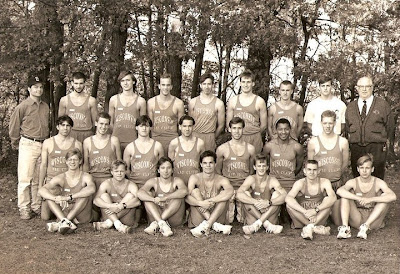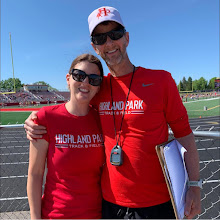Almost 6 months to the day I wrote
this post where I was seeking help regarding writing an article about mileage trumping ancillary training. I finally got around to writing this article. I didn’t include any specific examples yet, but I’m still considering it.
Building a Bigger Base A friend of mine ran a fall marathon with the outside goal of qualifying for Boston. Entering the race, she needed to drop 14-minutes from her PR. That’s a rather large chuck of time to drop in one race, but it’s doable. She had a very good race and was able to shave seven minutes from her PR. Like most runners, she started to think about a spring marathon and the training that would finally get her a well-earned Boston Qualifier (BQ). With winter on the horizon she told me, “I want to focus on speed.” Her plan is to cut her mileage and include more speed work because that’s what she thinks is holding her back from her BQ.
At first, I just bit my lip and nodded. The whole time I was thinking she has it backwards. Looking at her race splits, she was on-pace for her BQ until mile 23. Then the wheels started to fall off and she lost roughly two minutes per mile the rest of the way. To me, that means she can handle the pace needed to reach her goal, she just lacks the strength to carry that speed for 26.2 miles. Finally, I spoke up and told her I thought this winter would be the perfect time to focus on
more miles, not
fewer miles. I think developing a bigger mileage base will more likely push her to her goal, than more speed.
Of course, this isn’t an original thought. The famous New Zealand coach, Arthur Lydiard deserves much of the credit. His training philosophy revolves around the concept of stamina and endurance being prerequisites to which speed is later added. As he put it, “Speed and the ability to run while in oxygen debt can be developed in four to five weeks, so why waste a lot of time running intervals and speed work when performance is governed by the aerobic capacity?” Instead, Lydiard preached running a lot of miles and building a huge base, saying, “You must do as much aerobic running as you can. The minimum is three months. Four months is better, five is better still but anything less than three months is not enough.”
When I think about setting aside 3-5 months for base building, I can’t help but think of our Minnesota winters. If there’s a better time for base building in this area, I haven’t found it. If you think about it, the local road-racing scene typically lasts from March to October. That leaves the other four months of the year for building your aerobic capacity. Sure, winters can be tough around here, but I like to live by the adage “there isn’t bad weather, just bad clothing.” When you combine things like high-tech clothing, treadmills, indoor tracks, running at the Metrodome, etc., you’ll find that you can indeed
thrive during a Minnesota winter, instead of just
survive.
If your interest is piqued and you’d like to build a bigger base, there’s no better source than Lydiard. While his training philosophy may be misconstrued among the masses, it is well regarded among other coaches. Many people think his entire program simply involves slogging through at least 100 miles per week. However, that’s not the case at all. As Olympian Ron Daws, who was a big proponent of Lydiard, puts it in his book,
Running Your Best, “Mileage is important, but it isn’t everything. During your buildup ideally you should run the highest mileage you can without injury or exhaustion. As you become fitter and have reached a high but endurable weekly mileage, you shouldn’t try to run more miles, but more at or near the fastest pace you can without becoming anaerobic. Never make your target mileage a contest to see how much you can run. If you run so far you never run fast, you are doing it wrong.”
I used to hate reading any training article that included the phrase, “find what works for you.” I wondered why I couldn’t just read in black and white what to do to achieve my best results. Finding what works is often a trial and error approach that can be time consuming and frustrating. However, now I understand what a friend of mine means when he says, “We’re all an experiment of one.” Each runner is different in many ways (see sidebar) and we all have to experiment to find out what works best for us. This holds true whether we’re adding speed workouts, incorporating recovery days, or building our base mileage.
While there are many ways to go about increasing one’s mileage and building a bigger base, here are a few tactics that I’ve used with success. First, the 10% rule states that you should never increase your previous week’s mileage by more than 10%. I find this rule is most useful when you are building your mileage to levels you never reached before. If you ran 40 MPW all last year, but now you’re at 20 MPW, the 10% rule doesn’t really apply. You can ratchet back to 40 MPW quicker than the 10% rule would allow. However, if you want to take your mileage from, say 40 to 60 MPW, then increasing by no more than 10% each week is a wise move. Second, after building your weekly mileage for two or three weeks in a row, incorporate a cutback week where you reduce your mileage for the week. This will allow your body to recover and adapt to the increased stressed placed upon it before beginning another two to three week building phase. Third, as poet William Blake said, “You never know what is enough unless you know what is more than enough.” As you continue to build your mileage, be sure to listen to your body and be on the look out for signs of injury and exhaustion. Re-evaluate often and be flexible with your plan as problems arise. Finally, as you experiment with what level of weekly mileage is right for you, be aware that it will change over time as your season and career develop. Just because you got injured once at a certain level of training doesn’t mean you’ll never be able to handle that level again.
I understand that this type of program is not for everyone. It does take commitment and as Daws puts it, “Making a commitment to run comes down to how badly you want to explore your limits. It means honestly confronting your excuses. It means making time to train. If you do that, it will be incredible – running and improving from mileage formerly thought beyond your ability.” So, if you are serious about improving your running and pushing your limits, I encourage you to take a good hard look at your base building this winter. Lay out a plan that is beyond anything you’ve done before. Then once the snow is gone you can worry about adding speed workouts on top of your biggest base ever.
SIDEBARFrom Ron Daws’s
Running Your Best
Ten common factors affecting mileage are:
1 - Previous running experience.
2 - Mental tenacity.
3 – Durability.
4 - The events that you are training for.
5 - The speed at which you train.
6 - Outside activities.
7 - Amount of sleep.
8 - Emotional pressures.
9 - Phase of training (goals in training).
10 - One or two-a-day workouts.














































